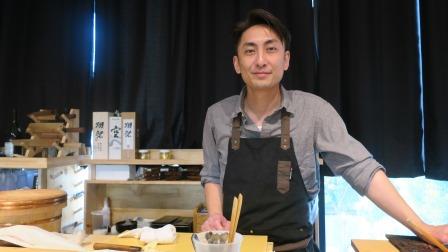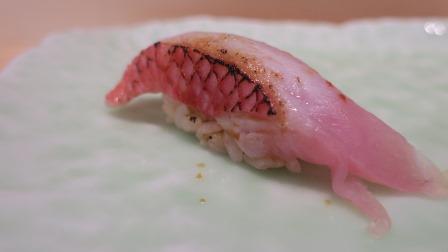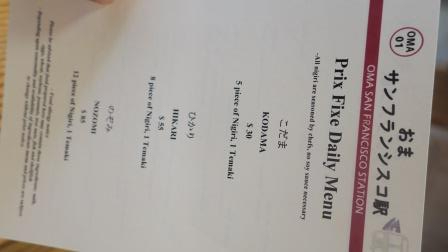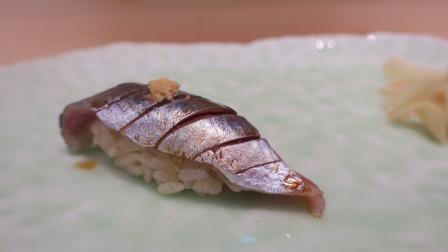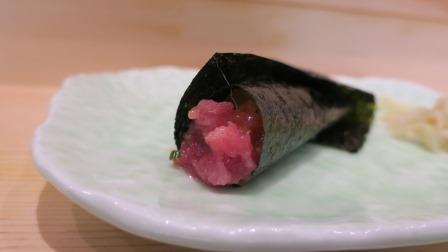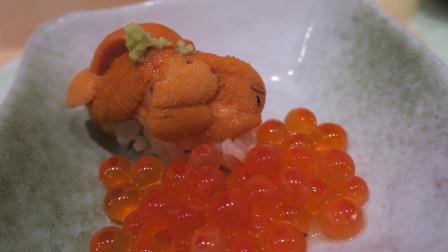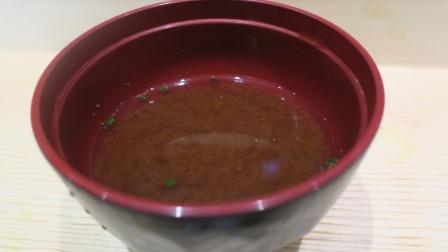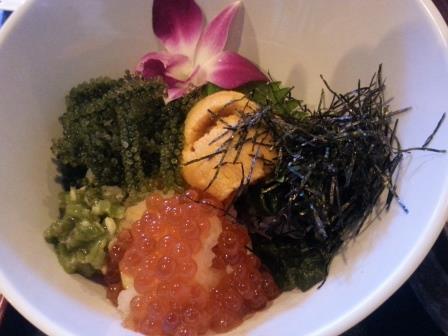“Highest-quality sushi you can taste at a metropolitan train station you happened to stop by” is the concept.
Text Mayumi Schroeder Photo: Elli Sekine
Growth of popularity of sushi in San Francisco’s Bay area in recent years is quite amazing. Many sushi restaurants including sushi bars and revolving sushi places have opened. Among them, one place is particularly attracting people’s attention as a restaurant where true authentic sushi is served. It is “Oma San Francisco Station”, which opened in Japan Town’s West Mall in July of 2018. This place has been featured in various media such as ABC News, Hoodline, and Eater SF as a retaurant where reasonably-priced high-quality sushi omakase courses are offered, and good reviews have been given. Even the Michelin Guide said, “It is wonderful that you can eat this good-quality sushi at this kind of price!”
Wilson Chan, the owner/chef, is Chinese American from Northridge area of Los Angeles County. He has a 16-year career as a chef, and has worked as a skillful chef at many high-quality restaurants such as“Wasabi + Ginger, Kentaro” in Los Angeles area, ”Yuzuki”, “Tsubasa”, ”Kappo Gomi”, and ”Ozaoza” in San Francisco area. For this opportunity of opening his own restaurant, Mr. Chan, who has also worked as an art designer, did everything from designing the modern interior, 3-dimentional art, to the website by himself.
The name of this restaurant, “Oma San Francisco Station”, with a wooden counter for only 8 seats, was named after an image in which, although you are in a metropolitan area, you go to a train station to taste omakase-style sushi. The menu consists of only 3 omakase courses, “Nozomi” ($85), “Hikari” ($55)”, and “Kodama ($30)”. The courses are uniquely named after Japanese bullet trains (Shinkansen). The “Nozomi” consists of 12 nigiri sushi pieces, and 1 hand-roll. The “Hikari” consists of 6 nigiri sushi pieces, and 1 hand-roll. “Kodama” consists of 5 nigiri sushi pieces, and 1 hand-roll. Each course ends with akadashi miso soup. If you felt not quite satisfied with the quantity, you can also add individual nigari sushi pieces of your choice.
As for the ingredients, Mr. Chan himself carefully selects only fresh and seasonal produce. On top of air ordering from Toyosu in advance, he also orders certain seasonal ingredients from even Hokkaido and Kyushu. As for fish, this place has rare kinds such as red bream, rockfish, red snapper, amberjack, and scallops from Iwate prefecture, which are not well known and usually unavailable as popular sushi ingredients. Each ingredient is prepared using uniquely effective methods such as konbu-jime, and aburi (charring), to enhance each ingredient’s characteristics to the fullest. The konbu for konbu-jime method is Rishiri dried kelp from Hokkaido. Mackerels from Hokkaido are marinated in dashi for 2 hours, and red breams are marinated for 6 hours before they are prepared. The ikura (salmon roes) dish I tasted was prepared after marinated in konbu dashi and mirin, and every bite was fresh, and soothing while I could still taste ikura’s natural deep taste and aroma, which slowly spread in my mouth. The charred salmon was very aromatic due to slight charring burn, and its soft texture that melted in my mouth made me feel like getting addicted to it. Simple, yet only highest-quality fish is used, therefore, “no soy sauce is needed”, is true as written in the menu. The best possible sushi has been created here by ultimately bringing out each ingredient‘s umami.
Presently, only sushi kaiseki can be offered because there is no kitchen space, however, he indicated his desire of opening a restaurant with a kitchen in the future. Right now, the seating is limited to 8, and the same-day reservation is not accepted, so making an online reservation in advance is recommended. Otherwise waiting can be very long especially for dinner time due to its popularity.
コンセプトは“都会で立ち寄った駅で食す最高級寿司”
近年におけるサンフランシスコ・ベイエリアでの寿司の人気は目を見張るものがあり、寿司バーや回転寿司など数多くの店舗が広範囲で展開されている。その中で、本格的な寿司が食べられるレストランとして注目されているのがサンフランシスコ日本街のウエスト・モール内に2018年7月にオープンした「Oma San Francisco Station」だ。リーズナブルに高品質の寿司のおまかせコースを食する事が出来るとABC7ニュースやHoodline、Eater SFなどの情報誌に取り上げられレビューでも高い評価を獲得している他、ミシュランガイドでも“この様な高品質の寿司を、この価格で食べられるのは素晴らしい事だ”と記載されている。
オーナー兼シェフのウィルソン・チャン氏はロサンゼルス市ノースリッジ地区出身のチャイニーズ・アメリカン。シェフとして16年の経験を持ち、ロサンゼルス市の「Wasabi + Ginger, Kentaro」、サンフランシスコ市の「Yuzuki」, 「Tsubasa」,「Kappo Gomi」や「Ozaoza」など数多くのクオリティーの高い店でシェフとして活躍してきた。今回、自分の店を持つにあたりシェフだけでなくアートデザイナーとしての経歴も持つチャン氏は、店内の近代的なデザインや立体アートからレストランのウェブサイトのデザインまで全て自分で作り上げたという。
8席の木製カウンターのみの当店の名前である“Oma San Francisco Station”は、“都会にありながら、駅に立ち寄って食べるおまかせ寿司”というイメージで付けられたという。メニューはおまかせメニューのみの全3種類。それぞれに“のぞみ(85ドル)”、“ひかり(55ドル)”、“こだま(30ドル)”と新幹線の名前を付けるユニークさだ。“のぞみ”では握り12貫と手巻き1本、“ひかり”では握り8貫と手巻き1本、“こだま”では握り5貫と手巻き1本で、全メニューとも最後に締めとして赤ダシの味噌汁が提供される。食後に物足りなさを感じる人には最後に1品ずつ握り寿司を追加する事もできるという。
食材は旬で新鮮な物のみをチャン氏が自ら選んで厳選、プレオーダーをして豊洲から空輸される他、九州や北海道からも旬の食材を空輸する徹底ぶり。寿司ネタにはキンメダイ、のどくろ、真鯛、かんぱち、岩手県産の帆立など一般の寿司ネタにはない物も取り揃えており、調理方法も昆布締めや炙りなどで個々の食材の旨さを最大限に生かすように調理されている。昆布締めに使用されているのは利尻昆布で、北海道産の鯖はダシに2時間浸してから、キンメダイは6時間浸してから調理されるという。今回、賞味させて頂いたイクラは昆布ダシと味醂で漬けられてから調理されており、噛む度に新鮮で爽やかな口当たりながらも、イクラそのものの深い味わいが口の中に広がっていく。又、炙りサーモンは若干の焦げがもたらす香ばしさと、柔らかな食感が口の中で溶けるようで病みつきになりそうだ。シンプルだが最高なネタを提供しており、メニューには“醤油は必要なし”と書かれているように、個々の素材の旨味を最大限に引き出した最高級の寿司を作り上げている。
現在はキッチンが無い為に寿司懐石のみの提供となっているが、将来はキッチン付きの寿司屋を開店したいとチェン氏は意欲を示している。席数が8席と限られおり同日予約を受け付けていない人気店の為、ディナー時には行列が出来る事も多いので事前にオンラインでの予約が推奨される。
Oma San Francisco Station
1737 Post Street., Suite 337, San Francisco, CA 94115
Website: https://www.omasfstation.com
Email: contact@omasfstation.com
Mon.- Sun. 12:00pm – 10:00pm
(Last Seating: 8:30pm)
Growth of popularity of sushi in San Francisco’s Bay area in recent years is quite amazing. Many sushi restaurants including sushi bars and revolving sushi places have opened. Among them, one place is particularly attracting people’s attention as a restaurant where true authentic sushi is served. It is “Oma San Francisco Station”, which opened in Japan Town’s West Mall in July of 2018. This place has been featured in various media such as ABC News, Hoodline, and Eater SF as a retaurant where reasonably-priced high-quality sushi omakase courses are offered, and good reviews have been given. Even the Michelin Guide said, “It is wonderful that you can eat this good-quality sushi at this kind of price!”
Wilson Chan, the owner/chef, is Chinese American from Northridge area of Los Angeles County. He has a 16-year career as a chef, and has worked as a skillful chef at many high-quality restaurants such as“Wasabi + Ginger, Kentaro” in Los Angeles area, ”Yuzuki”, “Tsubasa”, ”Kappo Gomi”, and ”Ozaoza” in San Francisco area. For this opportunity of opening his own restaurant, Mr. Chan, who has also worked as an art designer, did everything from designing the modern interior, 3-dimentional art, to the website by himself.
The name of this restaurant, “Oma San Francisco Station”, with a wooden counter for only 8 seats, was named after an image in which, although you are in a metropolitan area, you go to a train station to taste omakase-style sushi. The menu consists of only 3 omakase courses, “Nozomi” ($85), “Hikari” ($55)”, and “Kodama ($30)”. The courses are uniquely named after Japanese bullet trains (Shinkansen). The “Nozomi” consists of 12 nigiri sushi pieces, and 1 hand-roll. The “Hikari” consists of 6 nigiri sushi pieces, and 1 hand-roll. “Kodama” consists of 5 nigiri sushi pieces, and 1 hand-roll. Each course ends with akadashi miso soup. If you felt not quite satisfied with the quantity, you can also add individual nigari sushi pieces of your choice.
As for the ingredients, Mr. Chan himself carefully selects only fresh and seasonal produce. On top of air ordering from Toyosu in advance, he also orders certain seasonal ingredients from even Hokkaido and Kyushu. As for fish, this place has rare kinds such as red bream, rockfish, red snapper, amberjack, and scallops from Iwate prefecture, which are not well known and usually unavailable as popular sushi ingredients. Each ingredient is prepared using uniquely effective methods such as konbu-jime, and aburi (charring), to enhance each ingredient’s characteristics to the fullest. The konbu for konbu-jime method is Rishiri dried kelp from Hokkaido. Mackerels from Hokkaido are marinated in dashi for 2 hours, and red breams are marinated for 6 hours before they are prepared. The ikura (salmon roes) dish I tasted was prepared after marinated in konbu dashi and mirin, and every bite was fresh, and soothing while I could still taste ikura’s natural deep taste and aroma, which slowly spread in my mouth. The charred salmon was very aromatic due to slight charring burn, and its soft texture that melted in my mouth made me feel like getting addicted to it. Simple, yet only highest-quality fish is used, therefore, “no soy sauce is needed”, is true as written in the menu. The best possible sushi has been created here by ultimately bringing out each ingredient‘s umami.
Presently, only sushi kaiseki can be offered because there is no kitchen space, however, he indicated his desire of opening a restaurant with a kitchen in the future. Right now, the seating is limited to 8, and the same-day reservation is not accepted, so making an online reservation in advance is recommended. Otherwise waiting can be very long especially for dinner time due to its popularity.
コンセプトは“都会で立ち寄った駅で食す最高級寿司”
近年におけるサンフランシスコ・ベイエリアでの寿司の人気は目を見張るものがあり、寿司バーや回転寿司など数多くの店舗が広範囲で展開されている。その中で、本格的な寿司が食べられるレストランとして注目されているのがサンフランシスコ日本街のウエスト・モール内に2018年7月にオープンした「Oma San Francisco Station」だ。リーズナブルに高品質の寿司のおまかせコースを食する事が出来るとABC7ニュースやHoodline、Eater SFなどの情報誌に取り上げられレビューでも高い評価を獲得している他、ミシュランガイドでも“この様な高品質の寿司を、この価格で食べられるのは素晴らしい事だ”と記載されている。
オーナー兼シェフのウィルソン・チャン氏はロサンゼルス市ノースリッジ地区出身のチャイニーズ・アメリカン。シェフとして16年の経験を持ち、ロサンゼルス市の「Wasabi + Ginger, Kentaro」、サンフランシスコ市の「Yuzuki」, 「Tsubasa」,「Kappo Gomi」や「Ozaoza」など数多くのクオリティーの高い店でシェフとして活躍してきた。今回、自分の店を持つにあたりシェフだけでなくアートデザイナーとしての経歴も持つチャン氏は、店内の近代的なデザインや立体アートからレストランのウェブサイトのデザインまで全て自分で作り上げたという。
8席の木製カウンターのみの当店の名前である“Oma San Francisco Station”は、“都会にありながら、駅に立ち寄って食べるおまかせ寿司”というイメージで付けられたという。メニューはおまかせメニューのみの全3種類。それぞれに“のぞみ(85ドル)”、“ひかり(55ドル)”、“こだま(30ドル)”と新幹線の名前を付けるユニークさだ。“のぞみ”では握り12貫と手巻き1本、“ひかり”では握り8貫と手巻き1本、“こだま”では握り5貫と手巻き1本で、全メニューとも最後に締めとして赤ダシの味噌汁が提供される。食後に物足りなさを感じる人には最後に1品ずつ握り寿司を追加する事もできるという。
食材は旬で新鮮な物のみをチャン氏が自ら選んで厳選、プレオーダーをして豊洲から空輸される他、九州や北海道からも旬の食材を空輸する徹底ぶり。寿司ネタにはキンメダイ、のどくろ、真鯛、かんぱち、岩手県産の帆立など一般の寿司ネタにはない物も取り揃えており、調理方法も昆布締めや炙りなどで個々の食材の旨さを最大限に生かすように調理されている。昆布締めに使用されているのは利尻昆布で、北海道産の鯖はダシに2時間浸してから、キンメダイは6時間浸してから調理されるという。今回、賞味させて頂いたイクラは昆布ダシと味醂で漬けられてから調理されており、噛む度に新鮮で爽やかな口当たりながらも、イクラそのものの深い味わいが口の中に広がっていく。又、炙りサーモンは若干の焦げがもたらす香ばしさと、柔らかな食感が口の中で溶けるようで病みつきになりそうだ。シンプルだが最高なネタを提供しており、メニューには“醤油は必要なし”と書かれているように、個々の素材の旨味を最大限に引き出した最高級の寿司を作り上げている。
現在はキッチンが無い為に寿司懐石のみの提供となっているが、将来はキッチン付きの寿司屋を開店したいとチェン氏は意欲を示している。席数が8席と限られおり同日予約を受け付けていない人気店の為、ディナー時には行列が出来る事も多いので事前にオンラインでの予約が推奨される。
Oma San Francisco Station
1737 Post Street., Suite 337, San Francisco, CA 94115
Website: https://www.omasfstation.com
Email: contact@omasfstation.com
Mon.- Sun. 12:00pm – 10:00pm
(Last Seating: 8:30pm)







